Historic Blocks A (Old Arsenal Square) & B
Introduction
Text-to-speech Audio
Part of the United States Federal Armory at Harpers Ferry, Block A on Shenandoah Street (now known as Old Arsenal Square) included the two federal arsenal buildings that stored and distributed weapons. The arsenal buildings and their stores of firearms were the target of John Brown's Raid in 1859 and then the buildings were burned in April 1861 at the beginning of the Civil War. Block B of Shenandoah Street includes two of the only surviving buildings on the southern side of Shenandoah Street, including the Master Armorer's Quarters.
Images
Artist depiction of the Federal Armory at Harpers Ferry. The Large Arsenal building is in the center foreground with the Small Arsenal and Superintendent's Office in the same block.
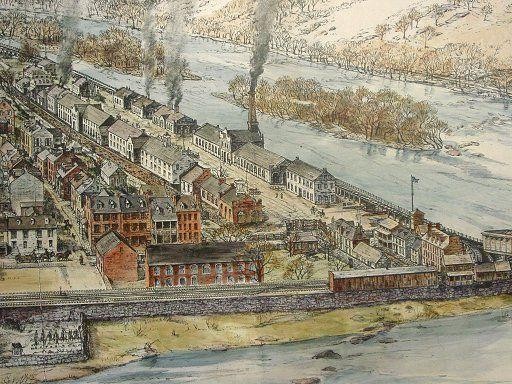
Blocks A & B (Harpers Ferry Historical Base Map, 1859)
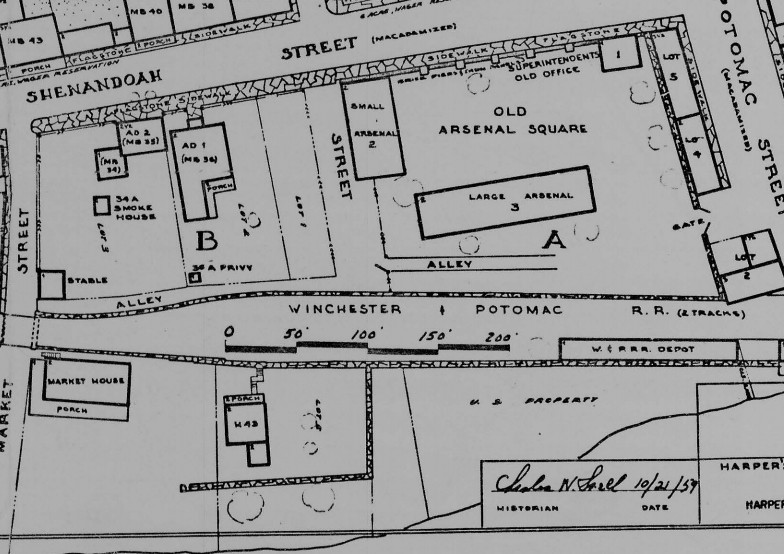
View of Harpers Ferry, 1896
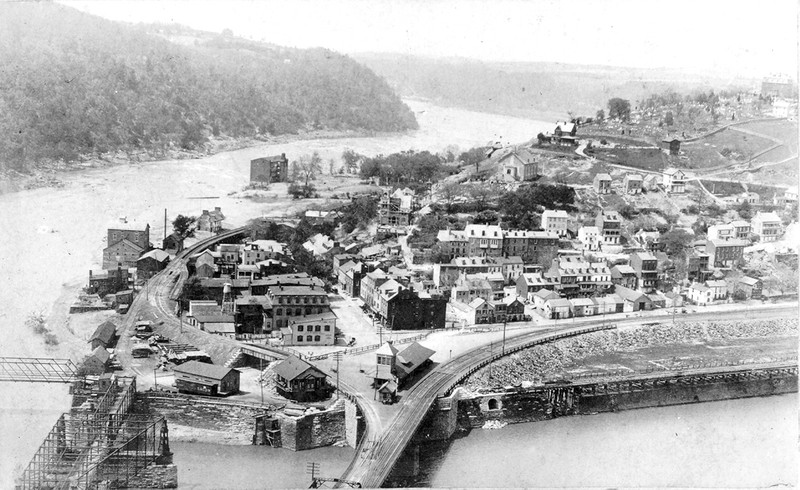
View of Harpers Ferry, 1896
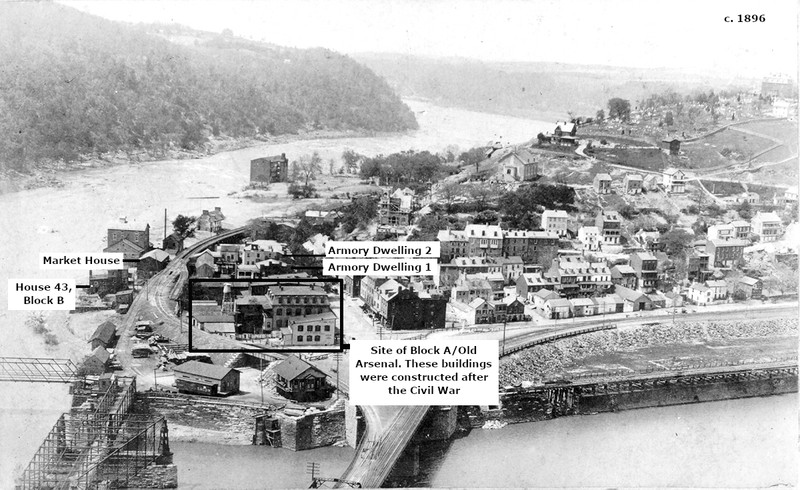
"St. Peter's Church & Rectory Lower Town, Harpers Ferry, circa 1895."
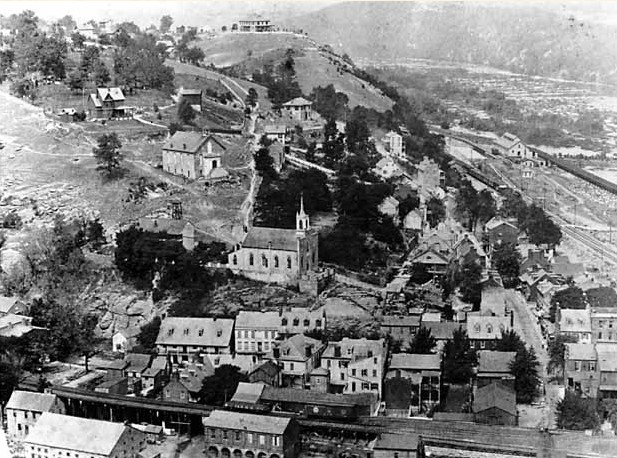
Labeled "St. Peter's Church & Rectory Lower Town, Harpers Ferry, circa 1895."
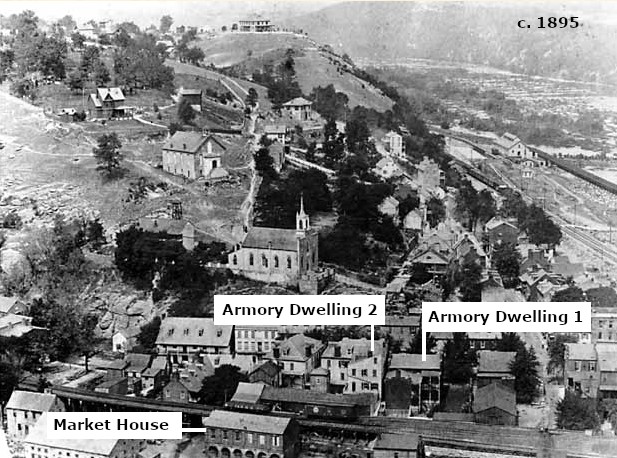
The two federal arsenal buildings burning on April 18, 1861 as the Federal force left Harpers Ferry after Virginia seceded from the United States.
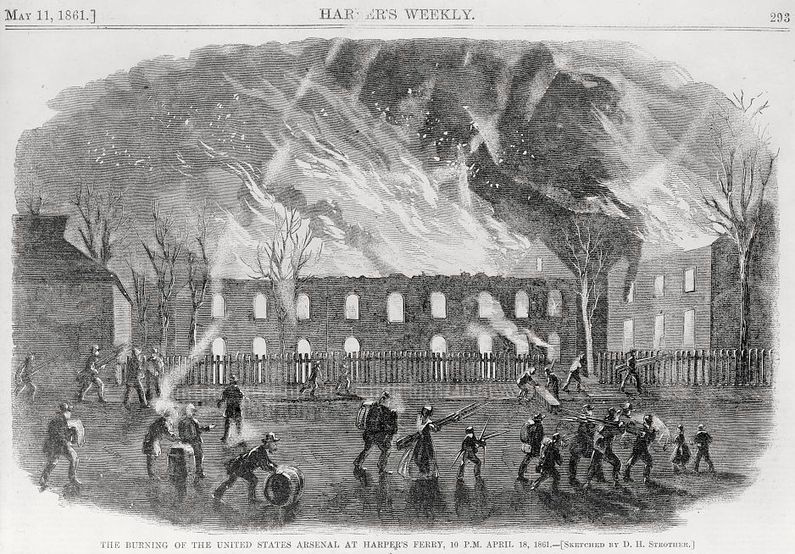
Foundations of the Small Arsenal Building
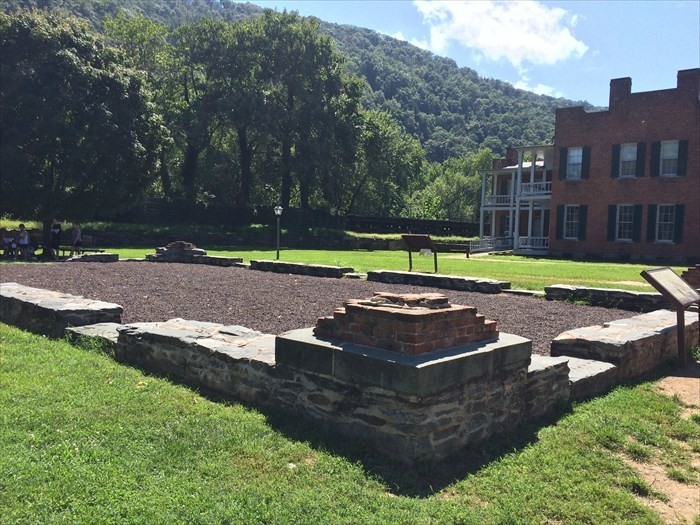
Wayside Marker for the Small Arsenal Building
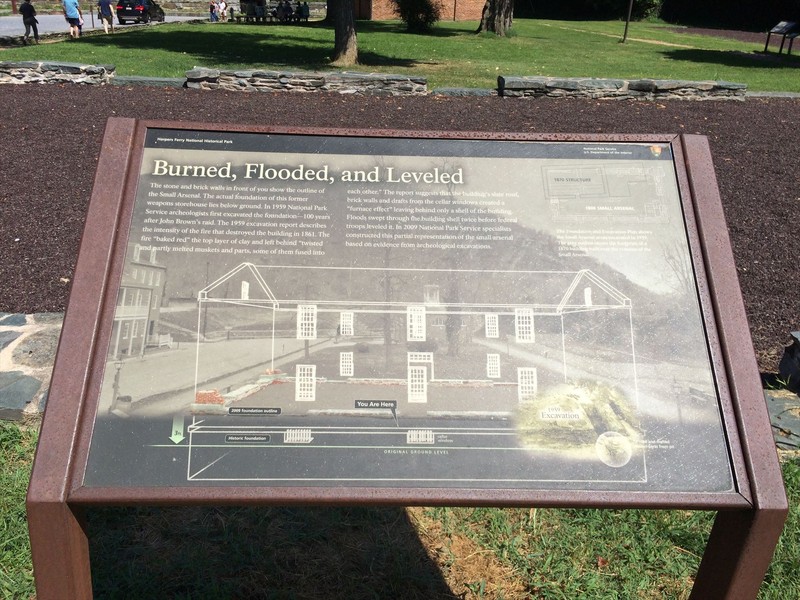
Wayside Marker for Small Arsenal Building
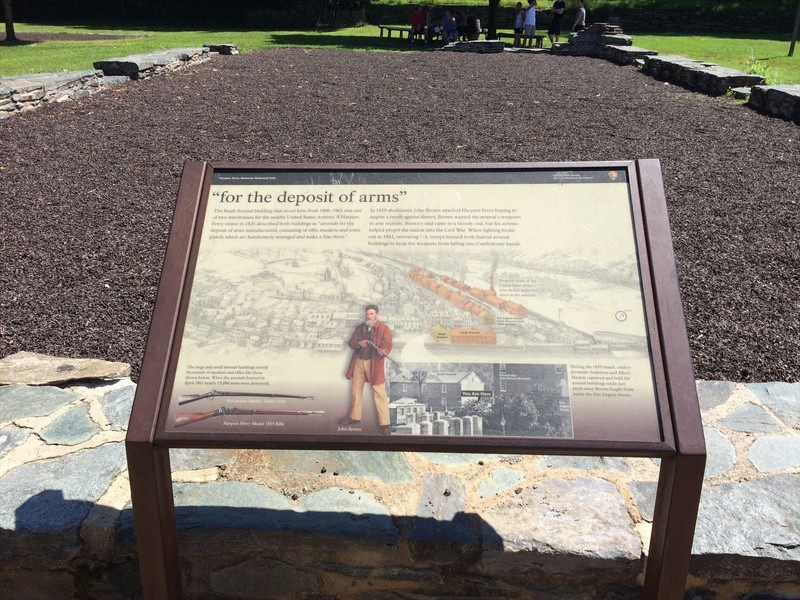
Foundations of Small Arsenal Building
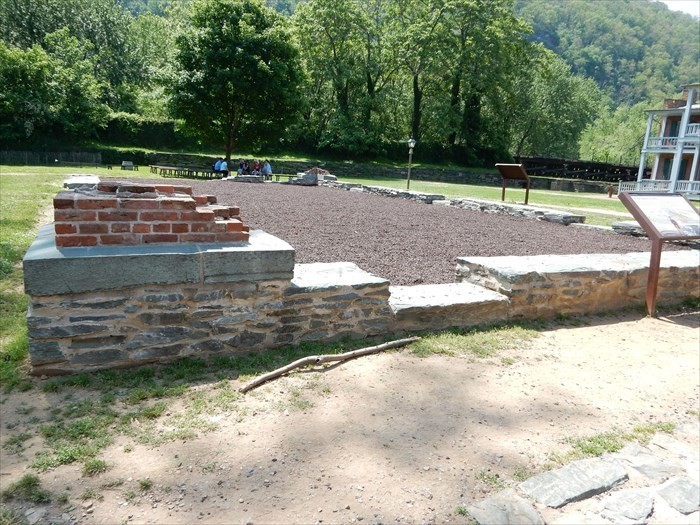
Armory Dwelling No. 1
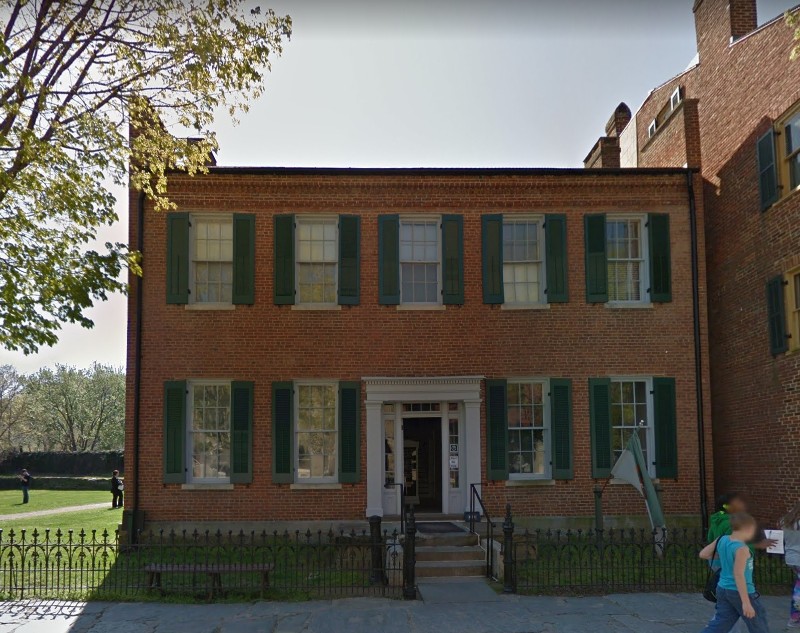
Armory Dwelling No. 2
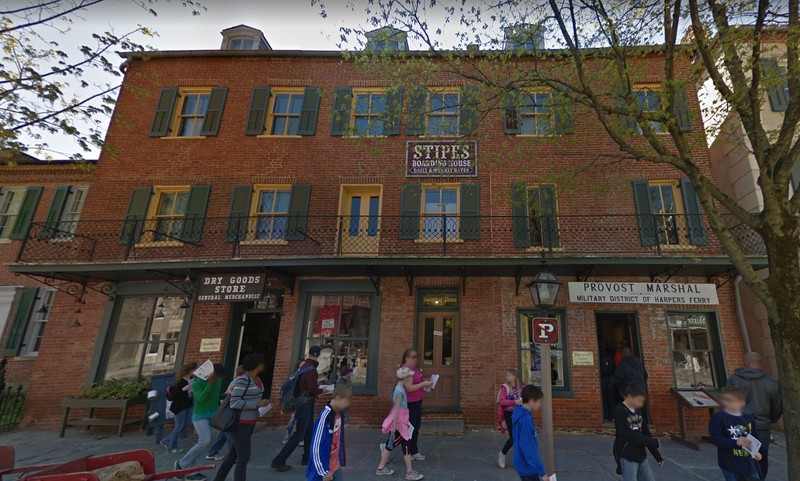
Map of NPS Park Building Locations and Numbers

Backstory and Context
Text-to-speech Audio
Descriptions of historic structures from the 1980 National Register of Historic Places Nomination:
Old Arsenal Square, Block A, Shenandoah Street
Building No. 1: Superintendent’s Old Office—“stood in the northeast corner of Old Arsenal Square. The one-story brick structure with slate roof, 28’ by 21’, was erected prior to 1832 as a dwelling house. It was converted to an office for the Armory superintendent in 1832 and served this function until 1848. In 1859 the building was being used by the Town of Harpers Ferry, under lease from the United States, as a town hall with offices for the mayor and town council. At the end of the Civil War it was in good condition and serving as a U.S. post office. Only portions of the foundation now remain.”
Building No. 2: Small Arsenal—“stood in the northwest corner of the square. Erected in 1806-1807, it was a two-story brick building measuring 68’ by 36’ with cellar, two-foot-thick walls, floors supported by stone columns, a slate roof, and no chimneys. It was used for the storage of arms. Federal troops burned the building on the night of April 18, 1861, to keep its 15,000 stands of arms out of Confederate hands. Only the ruined brick walls stood in 1865, and only portions of the foundations now remain.”
Building No. 3: Large Arsenal—“stood at the center of the square. Erected in 1799-1800, it was a two-story brick building measuring 125’ by 32’ with arched windows, no cellar, and no chimneys. It was used for the storage of arms, but because of its poor condition by 1859, only miscellaneous supplies were stored on the second floor. The first floor served to quarter the U.S. troops sent to guard the Armory as a result of the John Brown raid. Federal troops burned the building on the night of April 18, 1861, to deny it to the Confederates. After reroofing, the first floor was used by the Union Army in 1864-65 as a bakery supplying Sheridan’s forces. Only portions of the foundations are now extant.”
During the 1864-65 occupation of Harpers Ferry by the Union Army, three frame building were erected in Arsenal Square by the U.S. Military Railroad Corps: a mess house (61’ by 21’) with a wing; a 16’ by 166 building, and 18’ by 16’ building.
After the Civil War civilians bought plots on Arsenal Square and pulled down the ruins of the arsenal structures. Between 1869 and 1890 five brick and frame structures were constructed on Block A, largely with shops on the bottom floor and living quarters on top. These buildings were demolished by the National Park Service in the 1950s when they were removing post-Civil War structures.
Block B, Shenandoah Street
Market House—“designed by Maj. John Symington and erected in 1846-47 by the Armory, was located south of the Winchester and Potomac Railroad tracks in the southwestern sector of the block. The two-story brick building with slate roof and no cellar measured approximately 66’ by 40’. On the south side facing the Shenandoah River were six arched windows over six arched doorways. By 1859 a one-story covered frame porch had probably been added to the west (Market Street) end and across the Shenandoah River front to afford more space and protection for goods. The first floor then served as the public town market where vegetables, meat, poultry, cheese, tallow, eggs, and fish sold. The second floor was used as the lodge room of the Sons of Temperance, which funded its construction. The property was owned by the United States and leased to the Town of Harpers Ferry. The brick walls of the abandoned structure were felled by the 1936 flood. Foundation remnants are present under the existing parking lot.”
Lot No. 2: Armory Dwelling No. 1—“designed by Superintendent Henry W. Clowe and erected in 1858-59 as quarters for the Master Armorer. The two-story brick house has a slate roof and measures 42’ 8” by 38’6”. A two-story brick wing with slate roof at the rear measures 28’6” by 25’7”. A two-story wooden porch runs along the east side of the wing and the exposed rear of the main block. The building, which cost $7,000 to construct, contains 14 rooms. During the periods of Union occupation of Harpers Ferry during the Civil War, Union commanders probably used the house as a headquarters. The building has been restored to its 1859-65 appearance. A wood picket fence enclosed Lot No. 2 and the adjoining Lot No. 1. Park Bldg. No. 36A, located at the southwest corner of Lot No. 2, was a one-story brick privy, 9’ by 6’ with slate roof, erected previously in connection with Armory Dwelling No. 2. It is not extant.”
Lot No. 3: Armory Dwelling No. 2—“The earliest part ([Park Bldg] No. 35), erected in 1812 by Joseph S. Annin, was a 2-1/2-story brick house with cellar and slate roof measuring 33’ by 23’. It was the residence of the master Armorer from 1818 to 1838. The second part ([Park] Bldg. 34) was a one-story 22’-by20’ brick kitchen with slate roof erected in 1827 on the southwest corner of the original structure. Armory Dwelling No. 2 was vacant at the time of the John Brown raid and was used soon afterward as a recruiting office by the detachment of regulars sent to guard the Armory. It apparently served as quarters for Union officers during the Civil War. A third story was added to the building after 1878, and the structure has been stabilized in this form.
To the rear of this building was a one-story brick smokehouse with slate roof measuring about 16’ by 14’. This structure (Park Bldg. 34A) was raised to two stories after 1878 and remains in that form.”
Lot No. 5: House No. 43—“erected about 1800. This first quarters of the early paymasters was a two-story brick building measuring approximately 28’ by 30’ with a two-story frame porch across the north front, a cellar, and a slate roof. A two-story brick wing about 15’ by 15’ was located in the rear. The house was owned and occupied by George W. Gomf, an armorer, in 1859. It was destroyed by the 1936 flood, and only foundation ruins remain.”
Cite This Entry
Thompson, Kathleen. "Historic Blocks A (Old Arsenal Square) & B." Clio: Your Guide to History. October 18, 2021. Accessed March 21, 2025. https://theclio.com/entry/138714
Sources
"National Register of Historic Places Inventory--Nomination Form: Harpers Ferry National Historical Park." Accessed August 9, 2021. http://www.wvculture.org/shpo/nr/pdf/jefferson/66000041.pdf.
Bob O'Connor. "Harpers Ferry is the land the government keeps buying." Spirit of Jefferson. August 5, 2015. Accessed August 9, 2021. http://www.spiritofjefferson.com/news/opinion/article_48ac320e-3afe-11e5-99cb-db79a9fa9308.html.
"Harpers Ferry Historical Base Map, 1859, Part of the Master Plan, Harpers Ferry National Historical Park." Accessed August 9, 2021. http://npshistory.com/publications/hafe/map-1859.pdf.
"The Cotton Factory is the lone building visible alongside the Shenandoah River on Virginius Island when this photo was taken in 1896. (HF-96, Historic Photo Collection, Harpers Ferry NHP)" Cotton Factory. Dave Gilbert Graphic Design. Accessed August 9, 2021. http://www.dgilbert53.net/?page_id=826#gallery/827/166.
"The Cotton Factory is the lone building visible alongside the Shenandoah River on Virginius Island when this photo was taken in 1896. (HF-96, Historic Photo Collection, Harpers Ferry NHP)" Cotton Factory. Dave Gilbert Graphic Design. Accessed August 9, 2021. http://www.dgilbert53.net/?page_id=826#gallery/827/166. Edited by Kathleen Thompson.
"St. Peter's Church & Rectory Lower Town, Harpers Ferry, circa 1895." History of St. Peter's Church. Accessed August 9, 2021. http://www.histarch.illinois.edu/harper/hf-0099.html.
"St. Peter's Church & Rectory Lower Town, Harpers Ferry, circa 1895." History of St. Peter's Church. Accessed August 9, 2021. http://www.histarch.illinois.edu/harper/hf-0099.html. Edited by Kathleen Thompson.
"Harpers Ferry Arsenal and Armory." Fortwiki. Accessed August 9, 2021. http://www.fortwiki.com/Harpers_Ferry_Arsenal_and_Armory.
"Small Arsenal Building--Harpers Ferry, WV." Waymarking.com. Accessed August 9, 2021. https://www.waymarking.com/waymarks/WMZWP4_Small_Arsenal_Building_Harpers_Ferry_WV.
"Small Arsenal Building--Harpers Ferry, WV." Waymarking.com. Accessed August 9, 2021. https://www.waymarking.com/waymarks/WMZWP4_Small_Arsenal_Building_Harpers_Ferry_WV.
"For the deposit of arms'--Harpers Ferry, WV." Waymarking.com. Accessed August 9, 2021. https://www.waymarking.com/waymarks/wmZWNV_for_the_deposit_of_arms_Harpers_Ferry_WV.
"Small Arsenal Building--Harpers Ferry, WV." Waymarking.com. Accessed August 9, 2021. https://www.waymarking.com/waymarks/WMZWP4_Small_Arsenal_Building_Harpers_Ferry_WV.
Google Maps, Accessed August 9, 2021.
Google Maps, Accessed August 9, 2021.
Moyer, et al. "'To Preserve the Evidences of a Noble Past': An Administrative History of Harpers Ferry National Historical Park." Catoctin Center for Regional Studies, Frederick Community College, and Center for Heritage Resource Studies, Department of Anthropology, University of Maryland, 2004. Accessed October 18, 2021. http://npshistory.com/publications/hafe/adhi.pdf.

